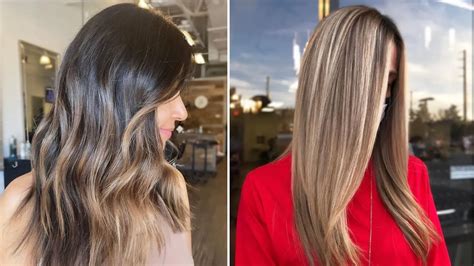Introduction
Balayage and highlights are two popular hair painting techniques that can add depth, dimension, and style to your locks. While both techniques involve lightening strands of hair, they have distinct differences in application, effect, and maintenance. This comprehensive guide will help you understand the nuances of balayage vs highlights, so you can make an informed decision about which technique is best for you.

Balayage
Overview:
Balayage, meaning “to sweep” in French, is a freehand hair painting technique that creates a natural, sun-kissed look. Hair color is applied in sweeping strokes, creating a soft blend from roots to ends with varying levels of lightness.
Benefits:
- Natural-looking results: Balayage mimics the effects of the sun, creating a gradual transition from dark to light shades, with no harsh lines or obvious roots.
- Versatile: Balayage can be customized to suit all hair types and textures, from fine to coarse and straight to curly.
- Low-maintenance: Balayage requires touch-ups less frequently than highlights, typically every 3-6 months.
Drawbacks:
- Time-consuming: Balayage can take longer to apply than highlights due to its freehand nature.
- Can be expensive: Balayage typically costs more than traditional highlights due to the time and skill required.
Highlights
Overview:
Highlights are a traditional hair painting technique that involves lightening individual strands of hair to create contrast and depth. They are applied using foils or a cap, which separate the lightened strands from the rest of the hair.
Benefits:
- Versatile: Highlights can be tailored to suit any desired look, from subtle to bold.
- Precision: Highlights offer more control over the placement and intensity of the lightened strands.
- Can brighten up dull hair: Highlights can add vibrancy and lift to otherwise flat-looking hair.
Drawbacks:
- Higher maintenance: Highlights require more frequent touch-ups, typically every 6-8 weeks.
- Can be damaging: Foils used in traditional highlighting can trap heat, potentially damaging hair.
- Noticeable roots: Highlights create distinct lines between the lightened strands and the natural hair color, which can become more noticeable as the hair grows out.
Table 1: Balayage vs Highlights Comparison
| Feature | Balayage | Highlights |
|---|---|---|
| Application | Freehand painting | Foils or cap |
| Effect | Natural, sun-kissed | Defined, contrasting |
| Maintenance | Every 3-6 months | Every 6-8 weeks |
| Cost | Higher | Lower |
| Damage potential | Lower | Higher |
| Roots | Less noticeable | More noticeable |
Key Differences
Application:
- Balayage is a freehand technique, while highlights use foils or a cap.
- Balayage creates a more blended look, while highlights produce more defined strands.
Effect:
- Balayage results in a soft, natural transition from dark to light shades.
- Highlights create a more dramatic contrast between the lightened strands and the rest of the hair.
Maintenance:
- Balayage requires less frequent touch-ups due to its gradual blending.
- Highlights require more frequent touch-ups to maintain the contrasting effect.
Common Mistakes to Avoid
- Over-bleaching: It’s important to avoid over-bleaching the hair, which can cause damage and breakage.
- Incorrect sectioning: Proper sectioning is crucial to ensure even distribution of color and prevent uneven results.
- Using low-quality products: Opt for professional-grade products that are formulated for hair painting techniques.
- Rushing the process: Allow ample time for the color to develop and avoid cutting corners.
- Not consulting a professional: For optimal results, it’s always best to consult with a licensed hair stylist who specializes in hair painting.
Understanding Customer Wants and Needs
Customers seeking balayage or highlights often have specific wants and needs:
- Natural-looking results: Many clients prefer the subtle, sun-kissed effect of balayage.
- Low maintenance: Customers with busy schedules may opt for balayage due to its infrequent touch-up needs.
- Versatile style: Both balayage and highlights can be customized to suit various hair types and desired looks.
- Damage prevention: Individuals concerned about hair damage may prefer balayage as it involves less bleaching and heat exposure.
- Unique expression: Clients seek hair painting techniques to reflect their individuality and style.
Conclusion
Balayage and highlights offer unique benefits and drawbacks, depending on individual preferences and hair needs. Balayage creates a natural, low-maintenance look, while highlights provide more defined contrast and versatility. By carefully considering the key differences and understanding the wants and needs of customers, you can make an informed decision about which technique is right for you.
Additional Tables
Table 2: Balayage Price Range
| Hair Length | Price Range |
|---|---|
| Short | $100-$250 |
| Medium | $250-$400 |
| Long | $400-$600 |
Table 3: Highlight Price Range
| Hair Length | Price Range |
|---|---|
| Short | $75-$150 |
| Medium | $150-$250 |
| Long | $250-$400 |
Table 4: Time Required for Balayage and Highlights
| Technique | Time Required |
|---|---|
| Balayage | 2-4 hours |
| Highlights | 1-3 hours |
Further Exploration: Creative New Applications
Hair painting techniques can be combined with other innovative approaches to create unique and captivating looks. Consider the following fresh ideas:
- Reverse balayage: Traditional balayage lightens the ends of the hair, while reverse balayage focuses on lightening the roots, creating a dramatic ombré effect.
- Under-highlights (also known as sombré): This technique involves adding darker tones beneath the surface layer of the hair, adding depth and dimension without harsh lines.
- Colormelt: Similar to balayage, colormelt blends multiple shades of color together, creating a seamless transition with no obvious divisions.
- Foilayage: A hybrid technique that combines balayage and highlights, foilayage uses foils to isolate strands for controlled lightening, resulting in a customized blend of tones.
- Micro-highlights: This technique involves applying tiny highlights to create subtle, natural-looking dimension.
